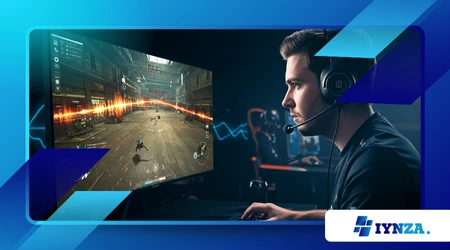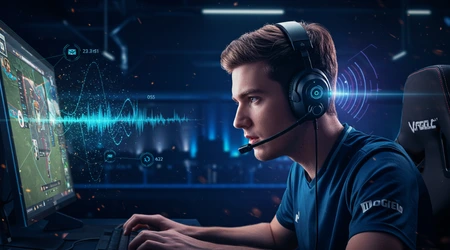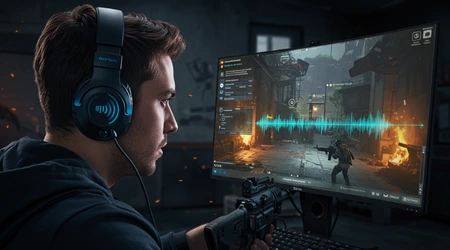The Role of Sound Cues in Winning More Rounds – Mastering Audio Awareness

The role of sound cues in gaming is often underestimated, yet it’s a game-changer for competitive players aiming to dominate.
Anúncios
In 2025, audio technology has evolved, with spatial audio and high-fidelity headsets amplifying immersion. Sound cues footsteps, reloads, or environmental shifts provide critical intel, sharpening situational awareness.
This guide dives into mastering audio to secure more victories, blending practical tips with strategic insights.
Ever wondered how pros always seem one step ahead? It’s not just reflexes; it’s their ears. Let’s explore how audio awareness can elevate your gameplay, from gear choices to tactical listening, ensuring you outsmart opponents in every round.
Why Sound Cues Are Your Secret Weapon
In competitive gaming, split-second decisions define victory. The role of sound cues lies in delivering real-time data that visuals alone can’t match.
Footsteps reveal an enemy’s position, while a distant explosion signals a shift in strategy. A 2023 study by the University of California found that players using high-quality audio setups reacted 15% faster to threats.
This edge is vital in fast-paced titles like Valorant or Call of Duty. Sound cues act like a radar, filling gaps where your eyes can’t reach. Ignoring them is like playing with one hand tied behind your back.
Audio awareness isn’t just about hearing; it’s about interpreting. Each sound in a game is a clue, deliberately designed to guide or warn.
For example, in Apex Legends, the distinct clank of a heavy weapon reload can signal a vulnerable opponent.
++ Crosshair Placement: The #1 Tip That Most Beginners Ignore
Pro players lean on this, adjusting their approach instantly. By training your ears, you transform noise into actionable intelligence, gaining a tactical upper hand.
Neglecting audio is a rookie mistake. Visual focus often overshadows sound, but enemies don’t always appear on-screen.
A creaking floorboard in Rainbow Six Siege can betray a flank, letting you counter before it’s too late. Mastering this skill turns you into a predator, not prey, in any match.

Choosing the Right Audio Gear
Your headset is your lifeline to the role of sound cues. In 2025, gaming headsets boast 3D audio and noise-canceling mics, but not all are equal.
Look for models with wide frequency ranges (20Hz–20kHz) for crisp highs and deep lows.
Brands like SteelSeries or HyperX lead with spatial audio tech, simulating 360-degree soundscapes. A budget option like the Razer Kraken X still delivers solid directional audio for under $50.
Comfort matters as much as tech. Long sessions demand lightweight designs with breathable ear cushions. Test for clarity in chaotic scenarios can you distinguish footsteps from gunfire?
A 2024 review by TechRadar praised the Audeze Mobius for its planar magnetic drivers, ideal for pinpointing sound origins. Invest in quality; cheap earbuds muddle critical cues.
Also read: Why Watching Your Own Replays is the Fastest Way to Improve
Don’t overlook software. Tools like Dolby Atmos or Windows Sonic enhance spatial audio, making directional cues sharper.
Pair your headset with a DAC (digital-to-analog converter) for cleaner sound. Your gear shapes how effectively you leverage audio intel, so choose wisely to stay ahead.
Training Your Ears for Tactical Advantage
Mastering the role of sound cues starts with active listening. Train in-game by isolating sounds: focus on footsteps, then gunfire, then ambient noise.
In Counter-Strike 2, practice in deathmatch mode, closing your eyes to identify enemy positions by sound alone. This builds muscle memory for audio-driven reactions. Over time, you’ll instinctively know a sniper’s perch from a single reload click.
Use sound cue drills. In Fortnite, land in quiet areas and listen for distant builds or pickaxe swings. Record sessions to review what you missed.
Read more: How to Build a Personal Strategy Guide for Any Game
Pros like Ninja emphasize “sound whoring” hyper-focusing on audio to predict movements. It’s not cheating; it’s strategy. Dedicate 10 minutes daily to these exercises for noticeable improvement.
Map familiarity boosts audio interpretation. Each game’s soundscape is unique wooden floors in Tarkov sound different from metal in Warzone.
Learn these nuances through repeated play. The more you understand a map’s audio profile, the better you’ll anticipate threats and opportunities.
Game-Specific Audio Strategies
Different games demand tailored approaches to the role of sound cues. In Valorant, agent abilities like Sova’s recon dart have distinct audio triggers, signaling when to push or retreat.
Study these signatures. For example, a faint “whoosh” might mean Phoenix’s blaze wall is up, giving you a window to flank. Create mental audio maps to track such cues.
In battle royales like Apex Legends, environmental sounds like ziplines or respawn beacons reveal squad movements. Picture a chessboard: each sound is a piece moving, betraying strategy.
If you hear a distant Wraith portal, expect a third-party ambush. Adapt your positioning to counter these audio tells.
Stealth games, like The Last of Us Part II, rely heavily on audio for survival. Enemy chatter or the rustle of grass can mean life or death.
Here, low-frequency sounds (like heavy breathing) signal proximity. Adjust your equalizer to amplify these, ensuring you never miss a lurking threat.
Avoiding Common Audio Pitfalls
Even pros can fumble the role of sound cues by ignoring pitfalls. Overreliance on visuals is a trap screens don’t show everything.
In Overwatch, a Reaper’s teleport sound can be missed if you’re tunnel-visioned on a teamfight. Stay alert to audio even during chaos. Ear fatigue is another issue; long sessions dull perception. Take breaks every hour to reset.
Poor audio settings sabotage performance. Cranking bass might feel immersive, but it drowns out subtle cues like distant footsteps. Balance your equalizer boost mids (1–4kHz) for clarity.
Finally, don’t ignore ambient noise in your room. A fan or TV can mask in-game sounds, so use noise-canceling headsets or play in a quiet space.
Misinterpreting cues is a silent killer. A reload sound might tempt a rush, but it could be bait. In Rainbow Six Siege, savvy players fake actions to mislead.
Cross-check audio with game sense does the cue align with the situation? Hesitate, analyze, then act to avoid falling for traps.
Leveraging Audio in Team Play

The role of sound cues shines brightest in team-based games. Clear comms paired with audio awareness create unstoppable synergy.
In Rainbow Six Siege, call out specific sounds like a barricade breaking to alert teammates. Use precise terms: “footsteps, top stairs, light armor” paints a clearer picture than “someone’s coming.”
Coordinate audio roles. Assign a “listener” in your squad to focus on sound cues during high-pressure moments. For example, in Valorant, one player can monitor for flank sounds while others push.
This divides labor, maximizing intel. A 2024 ESL Pro League report noted teams with dedicated audio roles won 20% more clutch rounds.
Practice sound-based strats. In Apex Legends, sync your squad to bait enemies with fake footsteps, luring them into traps.
Record team sessions to refine how you share audio intel. Over time, your team becomes a well-oiled machine, turning sound into a collective weapon.
Advanced Audio Techniques for Pros
For seasoned players, the role of sound cues extends to psychological warfare. In Tarkov, fake a reload to bait an enemy push, then ambush.
This exploits their reliance on audio cues, turning their strength against them. Similarly, in Valorant, use silent walking to create false silence, luring opponents into overconfidence.
Dynamic audio systems are evolving in 2025. Games like Hellblade II use adaptive soundscapes that shift with player actions.
Study these systems know when music swells signal a boss spawn or quietude hints at danger. Use tools like SoundID to customize your audio profile, emphasizing game-specific frequencies for maximum clarity.
Experiment with binaural audio mods, where available, for hyper-accurate directional sound. In Counter-Strike 2, mods like HRTF (Head-Related Transfer Function) enhance 3D audio, making enemy positions crystal clear.
Combine this with game sense to predict movements, like a chess master reading an opponent’s opening.
Table: Key Sound Cues in Popular Games (2025)
| Game | Sound Cue | What It Signals | Tactical Response |
|---|---|---|---|
| Valorant | Sova’s recon dart | Enemy position revealed | Reposition or prepare for push |
| Apex Legends | Respawn beacon activation | Squad reviving teammate | Ambush or avoid area |
| Rainbow Six Siege | Barricade breaking | Enemy breaching nearby | Set traps or hold angles |
| Counter-Strike 2 | Weapon reload | Opponent temporarily vulnerable | Push cautiously, confirm position |
| Fortnite | Pickaxe swing | Player mining resources | Flank or prepare for third-party |
This table highlights actionable sound cues across popular titles, guiding your in-game decisions.
Conclusion: Hear the Win, Feel the Victory
Mastering the role of sound cues transforms you from a casual player to a tactical maestro. In 2025, with audio tech advancing, leveraging sound is non-negotiable.
From choosing the right headset to drilling audio awareness, every step hones your edge. Think of audio as a sixth sense, like a spider’s web sensing prey.
By integrating these strategies gear optimization, game-specific tactics, team synergy you’ll outhear and outplay opponents.
Start today: tweak your settings, practice listening, and watch your win rate climb. Why settle for good when your ears can make you great?
Frequently Asked Questions
Q: How do I know if my headset is good enough for competitive gaming?
A: Check for a wide frequency range (20Hz–20kHz), comfort, and spatial audio support. Test in chaotic game scenarios for clarity.
Q: Can I improve audio awareness without new gear?
A: Yes, train active listening in-game, adjust equalizer settings, and minimize ambient noise to enhance focus on sound cues.
Q: Are sound cues more important than visuals?
A: They complement visuals. Sound reveals off-screen threats, like footsteps, while visuals confirm targets. Both are critical for success.
Q: How do I avoid misinterpreting sound cues?
A: Cross-check audio with game context. A reload might be bait, so verify with map knowledge before acting impulsively.
